Word to the Wise | Heather Noriega
by India Crowe
In recent years, artificial intelligence has become its own buzzword even sparking some speculation and debate. Will artificial intelligence (AI) replace humans in the workforce? What are the ethical implications of AI usage? What is artificial intelligence’s role in everyday life? While questions about AI continue to surface, researchers like Heather Noriega are already finding ways to utilize artificial intelligence for the good of humanity.
A PhD candidate of the Howard University College of Pharmacology, Noriega recently made significant progress on AI’s impact on drug discovery and development. Her work was featured in both Trade Magazine and the American Association of Pharmaceutical Scientists Magazine. She hopes her work contributes to equitable drug discovery and ultimately designs efficient and cost-effective treatments for underserved communities.
The Sway (TS): What kind of research do you do - can you provide details (projects you worked on, where/when and with whom)? Focus?
Heather Noriega (HN): My research focuses on using artificial intelligence and computational tools to solve complex problems in virology and oncology. Specifically, I’m working on two main projects as part of my PhD at Howard University College of Pharmacy.
The first project involves enhancing the packaging capacity and tissue tropism of viruses in the Parvoviridae family, especially Adeno-Associated Viruses (AAVs), which are important gene therapy vectors. I use AlphaFold2/AlphaFold3, a revolutionary AI system developed by Google DeepMind, to predict viral capsid structures, build 60-mer capsids in ChimeraX, and validate those structures against cryo-EM data. I also perform molecular dynamics simulations in GROMACS to study how mutations affect capsid stability. Then, using AI/ML, particularly deep learning (DL) and multilabel models, I model the relationship between sequence features and biological traits like packaging capacity and lung tropism, including analysis of AAV distribution in mouse/monkey tissues via collaboration with high-tech, local enterprise AAVner Gene Inc.
The second project focuses on structure-based analysis of antibody therapeutics, specifically Pertuzumab, to understand how glycosylation site variations and mutations impact structural integrity and receptor binding. I use AlphaFold3 to predict antibody-antigen conformations and apply GROMACS molecular dynamic simulations to examine how different Fc-region mutations affect stability and flexibility. By comparing conformational outcomes across variants, I aim to identify structural features that either enhance or hinder function, providing insight into design strategies that may improve therapeutic performance via collaboration with renowned Howard University researcher in nanomedicine, Dr. Emmanuel O. Akala.
Across both projects, I’m integrating AI/ML, structural biology, and simulation techniques to not only make predictions, but also to generate hypotheses for wet lab testing. My goal is to streamline the development of viral vectors and biologics using computational strategies that are both predictive and explainable.
TS: Did you experience any challenges while conducting your research on Artificial Intelligence and drug discovery and development? If so, how did you overcome them?
HN: Yes, several. One of the biggest challenges has been the quality and quantity of available data. AI models are only as good as the datasets they’re trained on, and in pharmaceutical research, data can be noisy, limited, or inconsistent. Another challenge is the skepticism some traditional researchers still have toward AI. I had to learn how to communicate the value of my work clearly, bridging the gap between computational methods and real-world biological impact. Overcoming these challenges requires persistence, interdisciplinary collaboration, and a willingness to constantly update my technical skills.
TS: How have the recent cuts of science funding impacted your research pursuits? How do you think it will impact the future of scientific research especially in your field?
HN: While I’ve been fortunate that my current work is supported by industry grants thus haven’t been directly affected by funding cuts, I recognize how fragile this stability can be especially in a field like AI-driven drug discovery, which is still emerging and often viewed as high-risk. Research in this space depends heavily on interdisciplinary collaboration, access to high-performance computing resources, and long-term support to validate computational predictions with experimental data. Cuts to funding jeopardize that pipeline.
In the long term, I worry that underfunding may slow the integration of AI into pharmaceutical sciences, particularly in underrepresented institutions and communities. This could widen existing disparities in who gets to lead innovation and who benefits from it. We need sustained investment not just in technology, but in diverse minds working to make it meaningful.
TS: In your view, what is the role of artificial intelligence in our society?
HN: AI is no longer just a tool. In healthcare and pharmaceutical sciences, AI has the potential to shorten the timeline from concept to treatment. But beyond that, it can help us detect patterns we may have never noticed. However, its role must be guided by ethical standards, transparency, and inclusion. AI should augment human decisions, not replace them.
TS: How has your academic journey at Howard University’s Graduate School shaped you as a person and a researcher? Any influential mentors or models along the way?
HN: Howard has shaped me not just as a researcher, but as a person grounded in purpose. Being part of a historically Black university has heightened my awareness of systemic inequities in science and the importance of representation. It’s given me a sense of responsibility to open doors for others. I’ve been fortunate to work with my mentor, Dr. Xiang Simon Wang, who has supported me in combining AI, molecular science, and health equity. I’ve also had the chance to mentor high school students, which has been incredibly rewarding and full circle for me.
TS: How do you hope your research will advance your field and society?
HN: I hope my work contributes to more equitable and efficient drug discovery pipelines. If we can design better treatments faster and more affordably and with underserved communities in mind,
we’re not just advancing science, we’re changing lives. I also hope my path encourages more women, mothers, and Latina scientists to pursue this kind of research. Representation in science is a form of innovation too.

